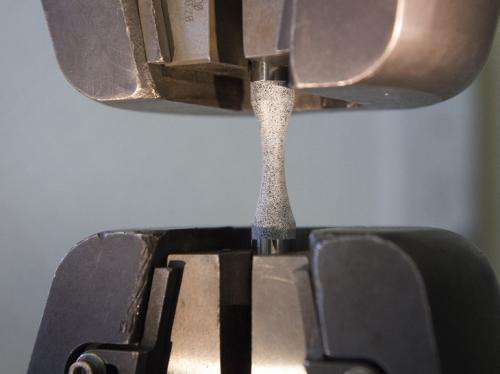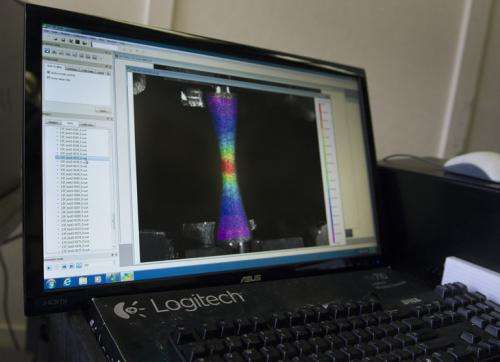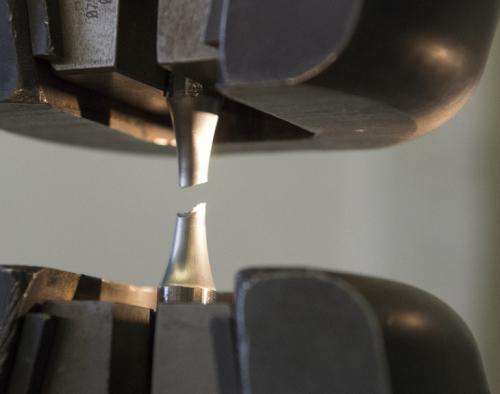Uncovering fracture models for advanced, high-strength steels

Steel is one of the most common structural materials, truly one of the foundations of modern civilization. An alloy of iron and carbon, steel has been made since biblical times. With two thousand years of experience in steelmaking, it would seem all there is to know about steel would already be known. But for Allison Beese, McFarlane Assistant Professor in Materials Science and Engineering, the secret world of steel is still unfolding.
"There is a lot known about traditional steels, but advanced, high-strength steels are a different story," says Beese. "Traditional fracture models don't accurately predict the properties of these advanced steels. We're still trying to understand the mechanisms for damage accumulation and fracture, and steel companies are very interested in developing other designs for steel."
The fine structure of fine steel
The best steels have high strength in conjunction with ductility, the ability to be stretched. Alloying small amounts of materials such as manganese can add to a steel's strength, while phase transformations during processing or deformation can change the steel from soft to extremely hard and strong.
For most of the history of steelmaking, metalworkers found out through trial and error how to produce steel with the qualities they wanted. They had no knowledge of "microstructure;" they just knew that certain ingredients and procedures worked.
One of the most famous steels ever made, called Damascus steel, was highly valued in ancient and medieval times for its strength, flexibility, and ability to hold an extremely sharp edge—traits that made it the material of choice for the production of swords and knives. (The vaunted Valyrian steel in the novel series and TV show Game of Thrones reportedly was modeled on Damascus steel.) The source of its unique qualities was a mystery until 2006, when a German research team found that a centuries-old blade of Damascus steel contains carbon nanotubes and cementite (iron carbide) nanowires, which must have been created during the forging process—a process whose details were lost in the late 1700s and have yet to be re-discovered.
Beese studies similar relationships between fine structure and overall characteristics, with an eye toward identifying what conditions will produce the features needed for different applications.
"I am primarily an experimentalist in trying to understand the connection between microstructure and macroscopic mechanical behavior," she says. "Through the understanding of deformation mechanisms, we can then develop predictive models."
In one kind of experiment, Beese and her students stretch pieces of high-strength stainless steel and use digital image correlation to quantify the resulting deformations. They first spray-paint a speckled pattern on the sample. Then, as a test machine pulls on the sample, a camera shooting at one-second intervals captures changes in the speckle pattern. Analysis of those changes reveals where, how much, and how fast the steel deforms.

Printing metals
Beese is also experimenting with metals in additive manufacturing, commonly known as 3D printing. In 3D printing, a material is laid down in thin layers, according to a digital pattern, until the entire structure is completed. This rapidly growing technology holds great promise for industry, but much remains to be learned, especially when it comes to printing metallic materials.
Penn State has been named the metals node for America Makes, a federally sponsored 3D printing initiative involving almost 100 companies, universities, labs, and other organizations. In the Center for Innovative Materials Processing Through Direct Digital Deposition (CIMP-3D), the resources and experience of Penn State's Applied Research Laboratory and Materials Research Institute are focused on developing a basic understanding of layer-by-layer fabrication in order to build structural components for automotive, aerospace, and other applications.
Discover the latest in science, tech, and space with over 100,000 subscribers who rely on Phys.org for daily insights. Sign up for our free newsletter and get updates on breakthroughs, innovations, and research that matter—daily or weekly.
With metallic materials, the metal is deposited in the desired location and then melted with a laser. As it cools and solidifies, it fuses to the layer below. Then the next layer is deposited and the cycle repeats. The repeated heating and cooling can alter the properties of the metal in a 3D product compared to the same material in a flat sheet or an ingot that was not made by layering.
Beese's group has been testing relatively large components, or walls, of an additively manufactured nickel superalloy, a stainless steel, and a titanium alloy. By carving out small samples from the walls, her group can measure the material's mechanical properties as a function of the location and direction of the layers. They have found that ductility depends on the direction of the build, while strength varies with height within the structure.
"Rapid thermal fluctuations as the laser heat source scans over the material one layer at a time will dictate the microstructure of the deposited metal, which in turn will dictate the mechanical properties," Beese explains. "People who directly make small 2D samples for testing are not going to see these differences, which are important since they will show up in large-scale structural components."

Becoming a mentor
For Beese, joining the Penn State faculty was something of a homecoming. She and her twin sister attended the university together in the 1990s.
"We are alike in that we are both very science- and math-oriented, and we both came to Penn State considering degrees in engineering. However, Sara found that she was very interested in life sciences, whereas I was more drawn to physics," she says.
Sara is now doing postdoctoral work in genetics at Harvard. Allison followed her bachelor's degree in mechanical engineering with a Ph.D. in the same field at MIT. Then, during her postdoctoral work at Northwestern, she began another important aspect of her career: mentoring graduate students.
Beese now has two graduate students and half a dozen undergraduates working on various projects in her lab. Early research experience played a key role in her own career choice, she says. As an undergraduate, she performed research for her honors thesis in the lab of Dominic Santavicca, professor of mechanical engineering.
"He and his group were developing a microengine, and I worked on experimental measurements for a thermal actuator to determine how much of the heat input could be converted to mechanical work, and subsequently, electricity," she recalls.
Now she's providing that kind of experience to a new generation of students.
"It's rewarding to mentor undergraduate and graduate students individually," she says. "It's especially helpful for undergraduates to have a chance to apply their classroom learning in the lab. My goal with respect to the graduate students is to help them to become independent researchers."
Provided by Pennsylvania State University




















